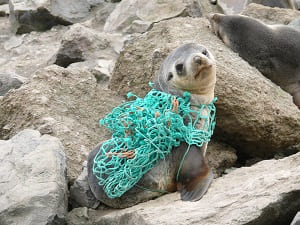Home › Sea Life › Project AWARE › Entanglement
Marine Life Entanglements
Entanglement in fishing gear and ocean debris, such as monofilament materials and plastics, is becoming a global threat to wildlife, especially marine mammals and turtles.
The information in this guide explains how marine animals become entangled and the proper steps for initiating an authorised entanglement response.
Why Do Marine Animals Become Entangled?
Distressing images of sea life snared in man-made fibers, nylons, and plastics have become far too commonplace.
If nothing else, it emphasises the urgent need to act! But what can we do to reduce the deadly impact on wildlife?
Furthermore, how do ocean advocates and ambassadors call for help - and who will respond?
We should be thankful that trained professionals are out there, working on the front lines of marine animal rescues around the world.
In addition, we should also accept and understand that the majority of these interventions are dangerous. Safely capturing at-risk marine life to remove entanglements is a high-risk job for the rescuers.
Marine life entanglement is not confined to local areas - it's a global problem. The deaths of hundreds of thousands of sea turtles and marine mammals occur every year, and it happens worldwide.
In the main, these defenceless creatures drown or starve. Marine debris restricts their normal behaviour, and they also suffer painful infections and physical trauma when trash cuts into their flesh.
Entanglement Harms Sea Animals and Wildlife
One of the biggest problems for water-based creatures is fishing gear entanglement. In fact, it affects more than 260 aquatic species, and it often results in a slow and painful death.
It doesn't take long for a small creature to drown if a heavy object is weighing it down. Hence, death by drowning kills a lot of dolphins, porpoises, shorebirds, small whales, and sea turtles.
Drowning is less of a risk for large whale species. Often, they can still swim as they pull an object that is attached to their body. Nonetheless, exhaustion and systemic infection would still be a serious threat to their survival.
The bottom line is this:
Even if an animal survives the initial trauma, there are other long-term effects associated with entanglement. They include fatigue, deformity (sometimes amputation), deteriorating health, decreased ability for reproduction, and of course - starvation.
What are the Biggest Risks to Marine Life?
The most vulnerable animals for getting entangled are birds, dolphins, seals, sea lions, turtles, and whales. Typical discarded objects that entangle marine animals, include:
 Fishing line
Fishing line- Food wrappers
- Frisbees
- Inner tubes
- Marine rope
- Plastic bags and packaging
- Plastic cutlery and straws
- Rubber balloons
- Styrofoam cups
Pro Tip: The risk of death from a vessel strike increases for entangled animals because they may be unable to use their normal body movement to escape. The International Whaling Commission (IWC) estimates 300,000 dolphins, porpoises, and whales die globally each year from entanglements.
What Can We Do to Help?
Trash and discarded human garbage is a common sight at beaches, parklands, and rivers. As a result, this litter or pollution often ends its journey in the ocean. This can present a severe entanglement risk for marine life.
But, there are several ways that the scuba diving community can help prevent marine animal entanglement. Plus, snorkelers and free divers also have an important role in prevention and for reporting injured wildlife.
Public awareness is very important. The general public can help solve the problem of entanglements. Furthermore, knowing what to do if we see a marine animal in distress (and what not to do) is crucial. For example:
- Do not leave monofilament (fishing line) or any waste items behind - especially near a waterway (e.g. if you go boating).
- Consider taking part in a local community clean-up effort in your area. You don't need to be a swimmer to clean up trash on dry land.
- Knowing how to get emergency help is an important part of marine animal entanglement awareness.
- Never take risks, and do not try to push a stranded animal off the beach.
- Contact a local organisation and wait for help. The Global Stranding Network is a world-wide collaboration of people who are responsible for rescuing stranded and entangled marine mammals. The global organisation has trained staff members that include marine biologists, conservationists, and veterinarians.
Important: Many public awareness campaigns help divers and non-divers use safer practices and support select ocean conservation programs (e.g. PADI AWARE Dive Against Debris).
Related Information and Help Guides
- 10 Tips for Divers to Protect and Conserve the Oceans
- How to Avoid Diver Entanglement Underwater?
- Project AWARE Ocean Protection and Conservation Programs
- What is Ocean Conservation and How Does it Work?
Note: The short video [3:01 seconds] presented by WWF-Canada contains safety information about how to approach and help entangled marine wildlife.